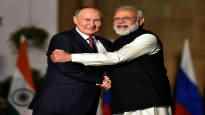The Russian Foreign Minister will visit New Delhi to seek support from among his underdeveloped partner countries.
India has become one of the biggest buyers of Russian products since the international community isolated Russia after its invasion of Ukraine.
In recent weeks, India has already bought almost as much oil from Russia as last year combined. India is also considering doubling its imports of coking coal from Russia and has increased its purchases of sunflower oil from the country.
– India imports more products from Russia, especially if they are at a discount, a source in the Indian government told Reuters.
Russian Foreign Minister Sergei Lavrov is currently on a two – day visit to the Indian capital, New Delhi.
He is expected to discuss, among other things, the ruble-rupee trade arrangement between the countries. For India could continue to buy goods from Russia despite the country’s sanctions on payment transactions.
Russia wants products from India that it will no longer receive from the West
India is highly dependent on imported energy. The rise in the price of oil as a result of the war in Ukraine has hit it hard, and the oil sold by Russia at a big discount is attracting a rather destitute giant state.
At the same time, Russia is in dire need of buyers for its oil.
However, India’s role as a buyer of Russian oil is still minimal, points out a senior adviser to the Bank of Finland’s Emerging Economies Research Institute. Laura Solanko. So far, only about one percent of Russian oil has gone to India, while more than half has gone to EU countries.
Even if oil exports to India increased tenfold, it would not solve Russia’s problems, Solango said.
– Several tanker crude oils are now going to India, but it is just a drop in the ocean. It’s hard to see India completely changing its oil supply and going to rely entirely on a Russian producer, he says.
Russia, for its part, could crave products from India that it does not now receive from the West. It hopes the same from China and Brazil.
– India would certainly be able to offer Russia a wide range of products and import routes for goods that are not made in India, he says.
Russia has been India’s “true friend”
India has not condemned Russia’s invasion of Ukraine, although it has called for a ceasefire in the war.
The use of India is explained not only by economic but also by historical reasons.
Relations between the two countries have been warm for decades. The Soviet Union significantly supported India, for example, in the 1971 war against Pakistan.
Russia has also been by far India’s most important arms supplier as India is armed for potential conflicts with its nuclear neighbors China and Pakistan.
Russia has been India’s “true friend,” unlike Ukraine, which voted against India’s nuclear program in 1998, said the leader of the Indian right-wing organization Hindu Sena, for example. Deutshe Wellen (switch to another service) in an interview.
India, like China and Russia, has long believed that the US dollar plays too much of a role in the international financial system.
– India is sympathetic to the idea that the world should be multipolar, Solanko says.
India has resorted to trade arrangements in the past
Indian exporters hope to be able to release the funds owed to them by Russian customers in this way.
– If the Europeans close the door, someone will open the door. There are a lot of opportunities for Indians in Russia now, Kotwani said.
According to a government source interviewed by Reuters, India and Russia are also discussing that payments would flow directly between the countries ’central banks.
The Reserve Bank of India ran a similar arrangement with the Soviet Union from 1970 to 1992. There was a bilaterally agreed exchange rate for certain products, and some of the products were sold in barter.
India, for its part, has bought oil through an arrangement by which it circumvented Western sanctions against Iran.
Solanko has doubts about the success of the India-Russia trade deal. Oil price formation would continue to take place in U.S. dollars and would not change with Russia’s “mighty order,” he points out.
He said it would be risky to commit to using an unstable Russian ruble as a billing currency at all.
US fails to put ‘red line’ on India
Solanko does not want to predict whether Lavrov’s visit to India will produce concrete agreements that would go beyond PR.
– It is likely that a handsome statement will be made about how both political and economic relations are good and are deepening, he thinks.
The United States has not criticized India very strongly for its policy on Russia. This is related to the “Pacific game,” where India is more important to the United States than the “European game,” Solanko says.
India and the United States are important trading partners and strategic partners for each other. The countries are united by the struggle against China. However, the United States would not take a warm look at the rapprochement between India and Russia, Solanko believes.
US Administration Sanctions Strategy Daleep Singh said during a visit to India on Thursday that the United States will not oppose India ‘s energy purchases from Russia as long as supplies do not “accelerate rapidly.”
“Friends don’t put red lines on each other,” Singh commented.
According to a U.S. government source who spoke to Reuters, energy purchases will be made to Washington as long as they are made at a discount.
However, according to Singh, the United States does not want to see its allies help bring the ruble back to life.
“We don’t want to see mechanisms designed to prop up the ruble, weaken the dollar-based financial system, or circumvent our economic sanctions,” he said.
